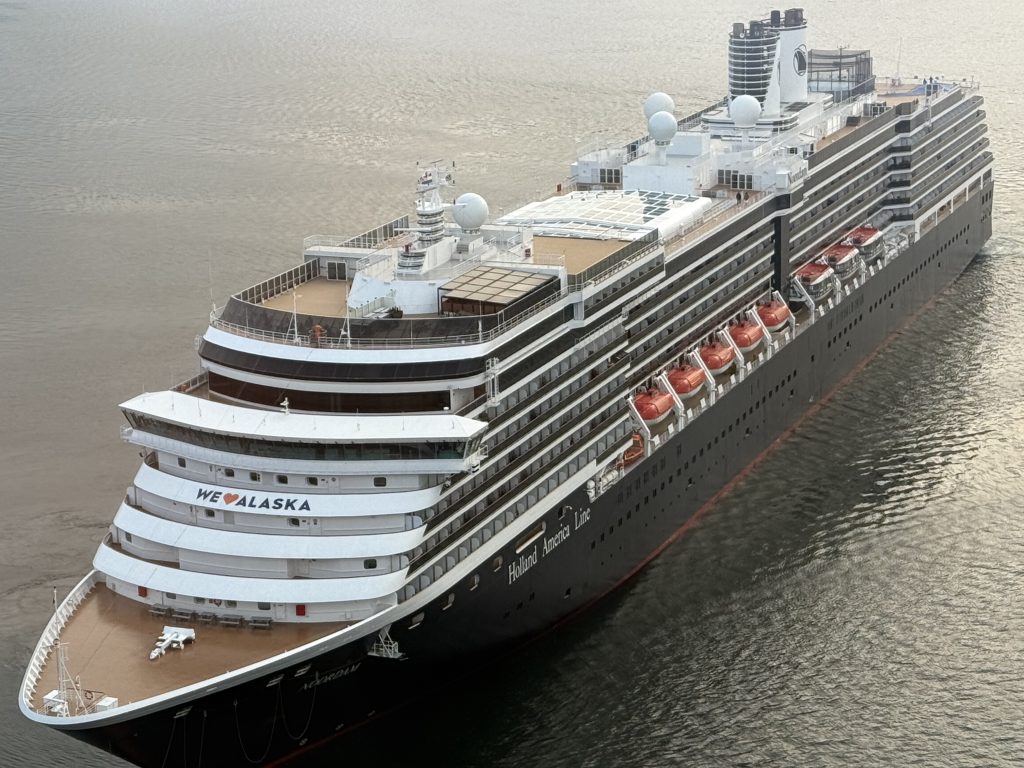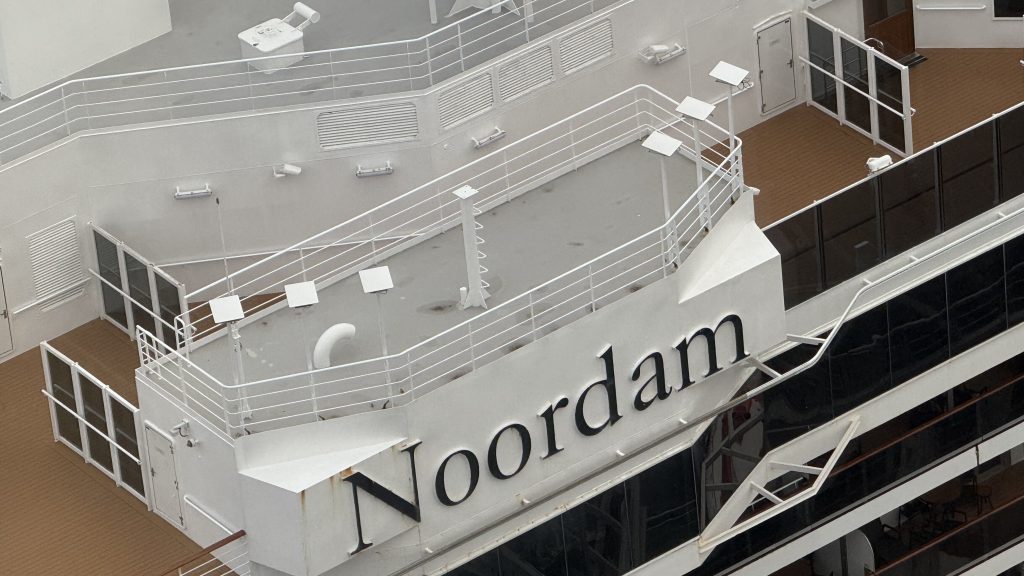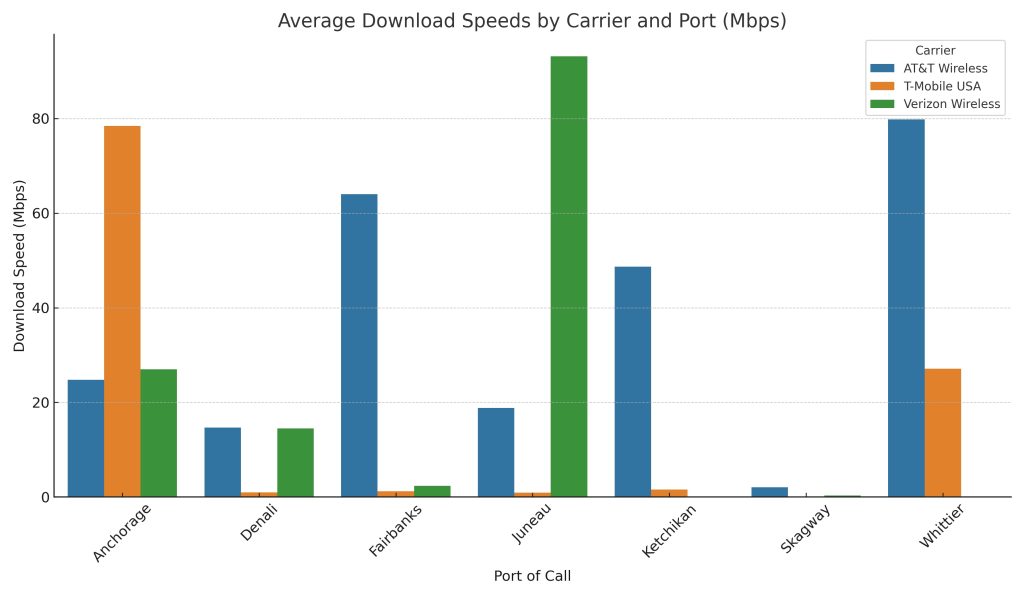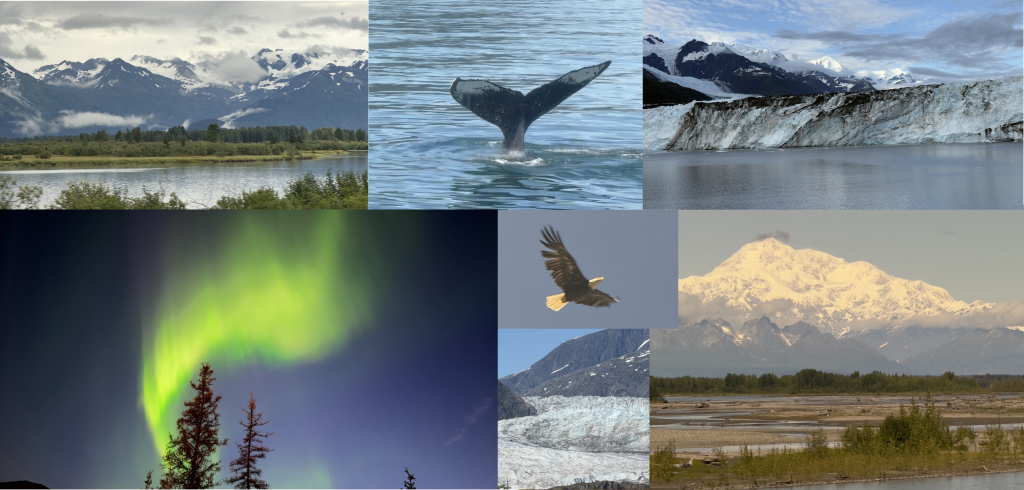
Table of Contents
Introduction
Alaska is one of the most breathtaking cruise destinations in the world—but it’s also one of the most challenging when it comes to cellular connectivity. Rugged mountains, fjords, remote towns, and sparse infrastructure mean that coverage varies dramatically by location and carrier. But if you need to stay connected which carrier offers the best Alaska Cruise Connectivity?
On a recent Holland America cruise from Vancouver to Alaska, I conducted dozens of SpeedSmart tests across Verizon, AT&T, T-Mobile, and the ship’s Starlink-powered Wi-Fi. Each test measured download/upload speeds, ping, and connection type (LTE, 5G NSA, etc.), providing a clear picture of how each carrier performed in different ports.
This post provides a port-by-port breakdown, explains why certain carriers excelled, and covers how Holland America’s adoption of Starlink (12 dishes per ship) has transformed onboard internet access.
How We Performed the Test
To ensure a fair and realistic comparison, we used a multi-carrier setup on a single device during the cruise:
- Primary Device: iPhone 16 Pro Max
- Verizon: Active on the physical SIM
- T-Mobile: Added via eSIM
- AT&T: Activated through US Mobile’s “Dark Star” plan, which runs on the AT&T network
This setup allowed us to run SpeedSmart tests for all three major U.S. carriers from the same phone, at the same time, under the same conditions. By testing on a single device, we eliminated device variability and ensured results reflected the true performance of each network.
Why This Matters for Travelers
If you’re traveling, you don’t need three phones to get full coverage. Modern smartphones (like the iPhone Pro series and many flagship Androids) support one physical SIM plus one or more eSIMs simultaneously. That means:
- You can keep your primary line active (e.g., Verizon).
- Add a secondary carrier via eSIM (e.g., T-Mobile, US Mobile/AT&T).
- Seamlessly switch or even run dual service while traveling.
For an Alaska cruise—where coverage varies dramatically by port—having all three carriers available on one phonegives you the best chance of staying connected everywhere.
Port-by-Port Results
Vancouver, BC (Departure Port)
- AT&T Wireless: 33.4 Mbps down / 15.8 Mbps up / 76 ms ping (5G NSA)
- Verizon Wireless: 17.2 Mbps down / 15.5 Mbps up / 115 ms ping (LTE)
- T-Mobile: 13.8 Mbps down / 6.4 Mbps up / 222 ms ping (5G NSA)
Winner: AT&T – Strongest 5G speeds in this major city.
Ketchikan
- AT&T Wireless: 48.7 Mbps down / 29.9 Mbps up / 84 ms ping
- Verizon Wireless: 0.1 Mbps down / 2.1 Mbps up / 268 ms ping
- T-Mobile: 1.6 Mbps down / 1.0 Mbps up / 264 ms ping
Winner: AT&T – Verizon and T-Mobile were nearly unusable.
Juneau
- Verizon Wireless: 93.1 Mbps down / 40.0 Mbps up / 82 ms ping
- AT&T Wireless: 18.8 Mbps down / 12.7 Mbps up / 73 ms ping
- T-Mobile: 0.9 Mbps down / 1.2 Mbps up / 128 ms ping
Winner: Verizon – By far the fastest in Alaska’s capital city.
Skagway
- AT&T Wireless: 2.1 Mbps down / 0.6 Mbps up / 103 ms ping
- Verizon Wireless: 1.7 Mbps down / 0.1 Mbps up / 129 ms ping
- T-Mobile: 0.7 Mbps down / 0.5 Mbps up / 139 ms ping
Winner: AT&T – But all three carriers struggled in Skagway.
Whittier
- AT&T Wireless: 19.7 Mbps down / 10.4 Mbps up / 84 ms ping
- Verizon Wireless: 12.0 Mbps down / 9.5 Mbps up / 79 ms ping
- T-Mobile: 4.5 Mbps down / 1.6 Mbps up / 120 ms ping
Winner: AT&T – The most consistent performer in Whittier.
Anchorage
- T-Mobile: 78.4 Mbps down / 24.2 Mbps up / 155 ms ping
- Verizon Wireless: 27.0 Mbps down / 27.3 Mbps up / 58 ms ping
- AT&T Wireless: 24.8 Mbps down / 13.0 Mbps up / 52 ms ping
Winner: T-Mobile – Surprisingly the fastest in Anchorage, though with higher latency.
Denali National Park
- AT&T Wireless: 14.7 Mbps down / 3.7 Mbps up / 66 ms ping
- Verizon Wireless: 14.5 Mbps down / 0.1 Mbps up / 76 ms ping
- T-Mobile: 1.0 Mbps down / 1.5 Mbps up / 196 ms ping
Winner: AT&T – Very limited coverage overall, but AT&T edges out.
Fairbanks
- AT&T Wireless: 64.0 Mbps down / 12.3 Mbps up / 64 ms ping
- Verizon Wireless: 2.4 Mbps down / 1.2 Mbps up / 63 ms ping
- T-Mobile: 1.2 Mbps down / 1.9 Mbps up / 171 ms ping
Winner: AT&T – Outstanding performance, Verizon and T-Mobile far behind.
Carrier Scorecard
- Vancouver: AT&T
- Ketchikan: AT&T
- Juneau: Verizon
- Skagway: AT&T (but all very weak)
- Whittier: AT&T
- Anchorage: T-Mobile (download leader)
- Denali: AT&T (slight edge in limited service)
- Fairbanks: AT&T
Overall Takeaways:
- AT&T: Strongest overall performer, winning most ports (including Fairbanks, Ketchikan, Whittier).
- Verizon: Shined in Juneau, decent in Anchorage, but weak in other stops.
- T-Mobile: Generally the weakest, except a surprising win in Anchorage.
Holland America’s Starlink Wi-Fi
One of the biggest breakthroughs wasn’t from the carriers at all—it was onboard. Holland America has equipped its ships with 12 Starlink dishes, delivering blazingly fast satellite internet to passengers.
Observed Performance:
- Download Speeds: 40–90 Mbps
- Upload Speeds: 5–20 Mbps
- Latency: Stable enough for Zoom calls and streaming
This is a game-changer compared to pre-Starlink cruise Wi-Fi, which was slow, expensive, and nearly unusable. Now, streaming Netflix, joining Teams calls, or backing up photos to the cloud is practical at sea.

Key Takeaways
- Best Overall Carrier: AT&T – won the most ports and delivered strong speeds.
- Strongest Single Port Result: Verizon in Juneau (93/40 Mbps).
- Surprise Performer: T-Mobile in Anchorage (78 Mbps down, though higher latency).
- Weakest Consistency: T-Mobile in most other ports.
- Most Reliable at Sea: Holland America’s Starlink Wi-Fi.
Conclusion
Alaska remains a challenging environment for cellular networks, but connectivity has dramatically improved thanks to modern 5G rollouts and Starlink adoption.
- AT&T was the most consistent and reliable across the cruise.
- Verizon had one outstanding win in Juneau but struggled elsewhere.
- T-Mobile showed a surprise in Anchorage but underperformed overall.
- Starlink Wi-Fi ensures passengers are never truly offline while at sea.

For travelers and businesses, the lesson is clear: AT&T is your best bet overall, Verizon can be strong in select ports, and Starlink guarantees reliable connectivity between destinations. If you are mostly in the lower 48 or do international traveling – please also consider T-Mobile as their coverage, T-Priority, T-Satellite, US Cellular acquisition – should keep them on your radar as well.
Also, please do disconnect, so you can see wonderful things Alaska has to offer, like these:


